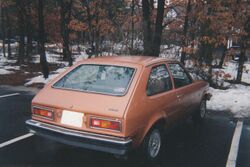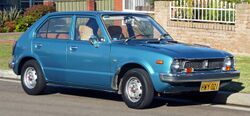Engineering:Econobox
Econobox is a United States informal slang term for a small, boxy, fuel-efficient economy car with few luxuries and a low price.
History
Econoboxes first came to prominence in the United States due to the 1973 oil crisis.[1] Japanese automakers were leaders at producing smaller, fuel-efficient cars, as well as enjoying generally higher reliability and build quality than their US counterparts,[2] so their offerings such as the Honda Civic[3] generally outperformed their American competitors such as the Chevrolet Vega and Ford Pinto.
The best-known American econoboxes were the 1970s/80s Chevrolet Chevette, Ford Pinto, Ford Escort and the Dodge Omni/Plymouth Horizon.[4][5] Japanese econoboxes include the Honda Civic (in particular the first and second generations) and the Datsun B-210. Other cars such as the Chevrolet Sprint, Geo Metro, Yugo[6] and Chevrolet Aveo as well as the Ford Festiva and Ford Aspire were considered econoboxes.[4]
Amongst the econoboxes were sold by American brands, many were manufactured in foreign countries. American car manufacturers in North America have typically had a hard time making money off of econoboxes, and they consider them "loss leaders" that only existed to meet CAFE fuel economy standards. So, over the course of time, American car companies shifted from manufacturing econoboxes themselves, and partnered with a foreign manufacturer to build them. An example of this is the American Ford Escort: the Escort replaced the Pinto in 1981, and was manufactured by Ford until 1990.[7] From 1991 to 1996, however, it was built using the Mazda B platform and the top trims featured a Mazda engine. Chevrolet did the same using its "GEO" line, to sell cars built by Suzuki and Toyota. Chrysler did as well, using cars built by Mitsubishi.
Today
The term "econobox" is not often used for describing new cars, partly due to the boxy styling of economy cars declining at the end of the 1980s.[8]
Many long-running nameplates that obtained their start as econoboxes have since moved upscale. For example, the Austin Mini and VW Beetle have been revived as enthusiasts luxury cars, rather than cheap transportation for the masses. Meanwhile, the Toyota Corolla, Mazda 3 and the Honda Civic started as subcompact econoboxes but are now on the high-end of the compact size line.[3] In 2023 the cheapest new car available in the United States is the Nissan Versa priced below US$20,000, with the cheapest trims starting at $16,000.
See also
References
- ↑ "Curbside Classic: 1977 Chevrolet Chevette – An Econobox For Garden-Variety Americans". http://www.curbsideclassic.com/curbside-classics-american/curbside-classic-1977-chevrolet-chevette-an-econobox-for-garden-variety-americans/. Retrieved 13 April 2018.
- ↑ "The not-so-Big Three". CBC News (CBC). 2008-06-03. http://www.cbc.ca/news/background/autos/bigthree.html. Retrieved 2008-08-08.
- ↑ 3.0 3.1 "Watch the Honda Civic Morph From 55-HP Econobox to 306-HP Mega Hatch". https://www.roadandtrack.com/car-culture/a13141716/honda-civic-hatchback-morph/. Retrieved 13 April 2018.
- ↑ 4.0 4.1 "Question of the Day: Most miserable econobox of all time?". https://www.autoblog.com/2016/07/22/question-of-the-day-most-miserable-econobox-all-time/. Retrieved 13 April 2018.
- ↑ "Ford Pinto: It's all relative". http://autoweek.com/article/car-life/ford-pinto-its-all-relative. Retrieved 13 April 2018.
- ↑ Furchgott, Roy (2021-06-10). "They Love the Yugo, the Car Others Love to Hate". https://www.nytimes.com/2021/06/10/business/yugo-cars.html.
- ↑ "Ford Escort History". https://www.edmunds.com/ford/escort/history.html. Retrieved 13 April 2018.
- ↑ "The 25 Greatest Boxy Cars of All Time". https://www.popularmechanics.com/cars/g891/the-box-rocks-10-cars-hip-to-be-square/. Retrieved 14 April 2018.
 |



